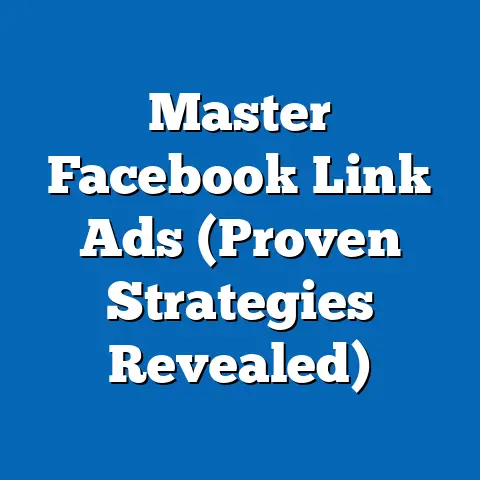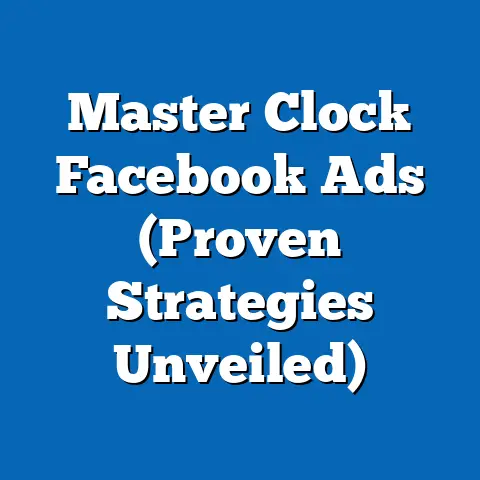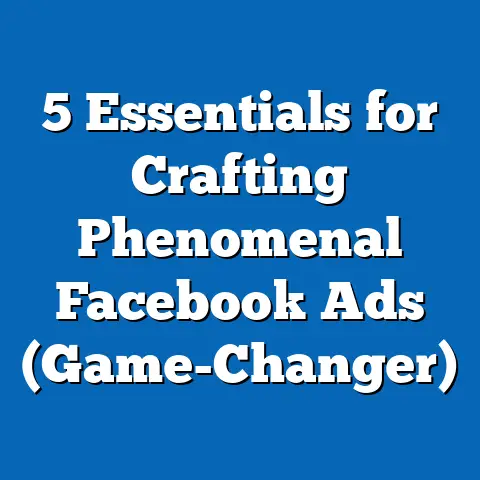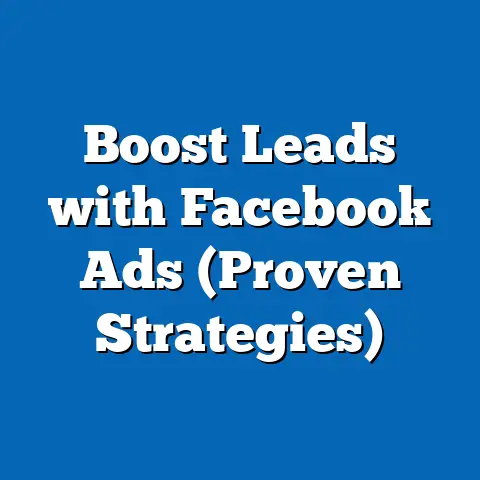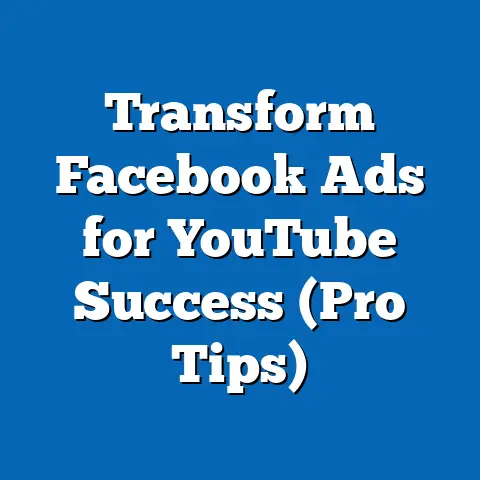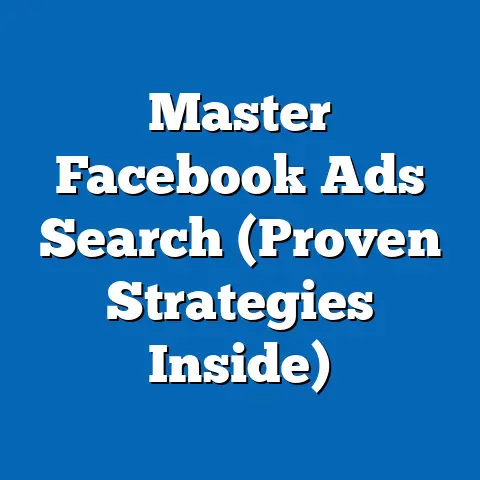Master Facebook Paid Advertising (Proven Strategies Inside)
Have you ever scrolled through Facebook and noticed some ads seem to magically appear, perfectly tailored to your interests, while others feel completely out of place? On one hand, you see an ad with hundreds of likes, shares, and comments, sparking lively conversations and driving engagement. On the other, there’s an ad with crickets chirping in the comment section, blending into the background like a digital wallflower. The difference? Mastering Facebook paid advertising.
Facebook paid advertising isn’t just about throwing money at ads; it’s about understanding the platform, your audience, and the art of crafting compelling content. It’s about strategically targeting the right people, with the right message, at the right time. In this article, I’m going to share proven strategies that will transform your Facebook ad campaigns from digital wallflowers to engagement magnets, driving real results and boosting your bottom line. I’ve spent years navigating the ever-changing landscape of Facebook Ads, and I’m excited to share my insights with you.
Section 1: Understanding Facebook Ads
At its core, Facebook Ads is a powerful system that allows businesses to reach a massive, highly targeted audience. It’s a sophisticated blend of art and science, where creative content meets data-driven targeting.
What are Facebook Ads and How Do They Work?
Facebook Ads are advertisements that businesses create and display on the Facebook platform. These ads can appear in various places, including the news feed, right column, in-stream videos, and even within Facebook Marketplace. They’re designed to interrupt the user’s experience, but in a way that’s relevant and engaging.
The magic behind Facebook Ads lies in its sophisticated ad auction system. Here’s how it works:
- Advertisers Set Bids: When creating an ad, advertisers specify how much they’re willing to pay for a particular action, like a click, an impression, or a conversion.
- Facebook Evaluates Ads: Facebook analyzes each ad based on several factors, including:
- Bid Amount: How much the advertiser is willing to pay.
- Ad Quality: Facebook assesses the relevance and quality of the ad based on user feedback and engagement.
- Estimated Action Rates: How likely users are to engage with the ad.
- The Auction Takes Place: Facebook runs an auction to determine which ads to show to users. The ads with the highest overall value (a combination of bid amount, ad quality, and estimated action rates) win the auction and are displayed to users.
- Bid Amount: How much the advertiser is willing to pay.
- Ad Quality: Facebook assesses the relevance and quality of the ad based on user feedback and engagement.
- Estimated Action Rates: How likely users are to engage with the ad.
It’s not just about who bids the most; it’s about who creates the most relevant and engaging ads. This encourages advertisers to create high-quality content that resonates with their target audience, ultimately benefiting both users and businesses.
Different Types of Facebook Ads
Facebook offers a variety of ad formats to suit different marketing goals and creative styles. Here are some of the most common types:
-
Image Ads: Simple yet effective, image ads feature a single image or graphic along with ad copy. They’re great for showcasing products, promoting events, or driving traffic to a website.
- Example: A local bakery uses an image ad featuring a mouthwatering photo of their signature cake to promote their online ordering service.
-
Video Ads: Video ads are highly engaging and can capture attention in a way that static images can’t. They’re perfect for telling stories, showcasing product demos, or building brand awareness.
- Example: A fitness app uses a video ad featuring users working out and achieving their fitness goals to promote their premium subscription.
-
Carousel Ads: Carousel ads allow you to display multiple images or videos in a single ad unit. Each image or video has its own headline, description, and link, making it ideal for showcasing multiple products or features.
- Example: An e-commerce store uses a carousel ad to showcase their latest collection of shoes, each with a different style and price point.
-
Collection Ads: Collection ads are designed for e-commerce businesses and feature a main video or image along with a selection of related products. They provide a seamless shopping experience directly within the Facebook app.
- Example: A clothing retailer uses a collection ad to showcase their new summer collection, allowing users to browse and purchase items directly from the ad.
-
Instant Experience Ads: These full-screen ads load instantly after a user clicks on them, providing an immersive and engaging experience. They can be used to showcase products, tell stories, or drive conversions.
- Example: A travel agency uses an Instant Experience ad to showcase stunning photos and videos of a tropical destination, enticing users to book their next vacation.
Image Ads: Simple yet effective, image ads feature a single image or graphic along with ad copy. They’re great for showcasing products, promoting events, or driving traffic to a website.
- Example: A local bakery uses an image ad featuring a mouthwatering photo of their signature cake to promote their online ordering service.
Video Ads: Video ads are highly engaging and can capture attention in a way that static images can’t. They’re perfect for telling stories, showcasing product demos, or building brand awareness.
- Example: A fitness app uses a video ad featuring users working out and achieving their fitness goals to promote their premium subscription.
Carousel Ads: Carousel ads allow you to display multiple images or videos in a single ad unit. Each image or video has its own headline, description, and link, making it ideal for showcasing multiple products or features.
- Example: An e-commerce store uses a carousel ad to showcase their latest collection of shoes, each with a different style and price point.
Collection Ads: Collection ads are designed for e-commerce businesses and feature a main video or image along with a selection of related products. They provide a seamless shopping experience directly within the Facebook app.
- Example: A clothing retailer uses a collection ad to showcase their new summer collection, allowing users to browse and purchase items directly from the ad.
Instant Experience Ads: These full-screen ads load instantly after a user clicks on them, providing an immersive and engaging experience. They can be used to showcase products, tell stories, or drive conversions.
- Example: A travel agency uses an Instant Experience ad to showcase stunning photos and videos of a tropical destination, enticing users to book their next vacation.
Choosing the right ad format depends on your marketing goals, target audience, and creative assets. Experiment with different formats to see what works best for your business.
Defining Your Target Audience
One of the biggest advantages of Facebook Ads is its powerful targeting capabilities. You can target users based on a wide range of criteria, including:
- Demographics: Age, gender, location, education, relationship status, and more.
- Interests: Hobbies, interests, and passions based on their Facebook activity.
- Behaviors: Purchase behaviors, device usage, travel habits, and more.
- Connections: People who are connected to your Facebook page, app, or event.
- Custom Audiences: Upload your own customer data (email addresses, phone numbers) to target existing customers or create lookalike audiences.
- Lookalike Audiences: Target users who are similar to your existing customers or website visitors.
The more specific you can get with your targeting, the more likely you are to reach the right people with your ads. For instance, if you’re selling organic baby food, you might target parents aged 25-45 who are interested in organic products and healthy eating.
My Experience: I once worked with a client who was selling high-end fishing gear. Initially, they were targeting a broad audience of “outdoor enthusiasts.” By narrowing their targeting to people specifically interested in “fly fishing” and “bass fishing,” we saw a significant increase in engagement and sales.
Key Takeaway: Understanding Facebook Ads involves grasping the ad auction process and the diverse ad formats available. Defining your target audience with precision is crucial for maximizing the effectiveness of your campaigns.
Section 2: Setting Up Your Facebook Ads
Now that you have a solid understanding of Facebook Ads, let’s dive into the practical steps of setting up your campaigns.
Creating a Facebook Ads Account
Before you can start running ads, you’ll need a Facebook Ads account. Here’s how to set one up:
- Create a Business Manager Account: If you don’t already have one, go to business.facebook.com and create a Business Manager account. This is a central hub for managing your Facebook pages, ad accounts, and other business assets.
- Link Your Facebook Page: In Business Manager, add your Facebook page to your account. This will allow you to run ads on behalf of your page.
- Create an Ad Account: Within Business Manager, create an ad account. You’ll need to provide your business information, payment method, and time zone.
Pro Tip: Use a separate ad account for each business or client you manage. This will help you keep your campaigns organized and track performance more effectively.
Setting Clear Advertising Goals
Before launching a campaign, it’s essential to define your advertising goals. What do you want to achieve with your ads? Here are some common objectives:
- Brand Awareness: Increase awareness of your brand among your target audience.
- Reach: Show your ads to the maximum number of people possible.
- Traffic: Drive traffic to your website or landing page.
- Engagement: Encourage users to like, comment, share, or react to your ads.
- Lead Generation: Collect leads from potential customers using lead forms.
- Conversions: Drive sales or other desired actions on your website or app.
- App Installs: Encourage users to download and install your app.
- Video Views: Increase the number of views on your video ads.
Choosing the right objective is crucial for optimizing your campaign for success. Facebook will optimize your ads based on the objective you select, so make sure it aligns with your overall marketing goals.
Campaign Structure: Campaign, Ad Set, Ad
Facebook Ads campaigns are structured in a hierarchical manner, with three main levels:
- Campaign: The campaign level defines your overall advertising objective (e.g., brand awareness, traffic, conversions).
- Ad Set: The ad set level defines your target audience, budget, bidding strategy, and ad schedule. You can have multiple ad sets within a single campaign, each targeting a different audience or using a different bidding strategy.
- Ad: The ad level contains the actual ads that will be shown to users. You can have multiple ads within a single ad set, each with different creative elements or messaging.
Optimizing each level of the campaign structure is essential for maximizing your results. Here are some tips:
- Campaign Level: Choose the right advertising objective based on your overall marketing goals.
- Ad Set Level: Define your target audience with precision, set a realistic budget, and choose the right bidding strategy.
- Ad Level: Create compelling ad content that resonates with your target audience and aligns with your campaign objective.
My Experience: I’ve seen many campaigns fail because advertisers didn’t take the time to properly structure their campaigns. For example, one client was running a conversion campaign but had set their target audience too broadly. By narrowing their targeting and creating separate ad sets for different audience segments, we were able to significantly improve their conversion rate.
Key Takeaway: Setting up your Facebook Ads campaigns involves creating a Business Manager account, defining your advertising goals, and structuring your campaigns effectively. Optimizing each level of the campaign structure is crucial for maximizing your results.
Section 3: Crafting Compelling Ad Content
The heart of any successful Facebook ad campaign lies in its content. Even the most precisely targeted ad will fall flat if the creative isn’t compelling.
Eye-Catching Visuals and Compelling Ad Copy
Your visuals are the first thing people will notice when they see your ad. Make sure they’re high-quality, relevant, and visually appealing. Here are some tips:
- Use High-Resolution Images: Avoid blurry or pixelated images.
- Choose Relevant Visuals: Select images or videos that are relevant to your product, service, or offer.
- Use Eye-Catching Colors and Designs: Experiment with different colors, fonts, and designs to see what grabs attention.
- Showcase Your Product or Service: Highlight the benefits of your product or service in your visuals.
- Use Emotion: Evoke emotion in your visuals to connect with your audience on a deeper level.
Your ad copy should be clear, concise, and persuasive. Here are some tips:
- Start with a Hook: Grab attention with a compelling headline or opening sentence.
- Highlight the Benefits: Focus on the benefits of your product or service, not just the features.
- Use Strong Verbs: Use action-oriented verbs that encourage users to take action.
- Keep it Concise: Get to the point quickly and avoid jargon.
- Speak to Your Target Audience: Use language that resonates with your target audience.
Pro Tip: Use a tool like Canva to create professional-looking visuals for your ads. They offer a wide range of templates and design elements to help you create eye-catching content.
Effective Headlines and Calls to Action (CTAs)
Your headline and CTA are two of the most important elements of your ad. They’re what will ultimately convince people to click on your ad and take action.
Here are some tips for writing effective headlines:
- Keep it Short and Sweet: Aim for headlines that are 5-7 words long.
- Use Numbers and Statistics: Numbers and statistics can make your headlines more credible and attention-grabbing.
- Ask a Question: Asking a question can pique curiosity and encourage users to click on your ad.
- Highlight a Benefit: Focus on the benefit of your product or service in your headline.
- Create a Sense of Urgency: Use words like “now,” “today,” or “limited time” to create a sense of urgency.
Here are some examples of high-performing CTAs:
- Shop Now: Perfect for e-commerce businesses.
- Learn More: Ideal for educational content or services.
- Sign Up: Great for collecting leads or building an email list.
- Get Started: Encourages users to try your product or service.
- Download Now: Perfect for promoting apps or downloadable content.
My Experience: I’ve found that testing different headlines and CTAs is one of the most effective ways to improve ad performance. I once ran an A/B test on an ad for a software product, testing two different headlines: “Simplify Your Workflow” vs. “Boost Your Productivity.” The “Boost Your Productivity” headline resulted in a 20% higher click-through rate.
A/B Testing Ad Content
A/B testing, also known as split testing, is the process of testing two different versions of an ad to see which one performs better. It’s a powerful way to optimize your ad content and improve your results.
Here’s a step-by-step guide on how to conduct A/B tests on different ad elements:
- Identify What to Test: Choose one element of your ad to test, such as the headline, image, or CTA.
- Create Two Versions: Create two versions of your ad, each with a different variation of the element you’re testing.
- Run Your Test: Run your ads simultaneously, making sure to target the same audience and use the same budget.
- Analyze the Results: After a sufficient amount of time (usually a few days or weeks), analyze the results to see which version performed better.
- Implement the Winning Version: Implement the winning version of your ad and continue testing other elements to further optimize your content.
Pro Tip: Use Facebook’s built-in A/B testing tool to make the process easier. It allows you to create and track your tests directly within the Ads Manager.
Key Takeaway: Crafting compelling ad content is essential for success on Facebook Ads. Use high-quality visuals, write persuasive ad copy, and test different headlines and CTAs to see what resonates with your target audience. A/B testing is a powerful tool for optimizing your ad content and improving your results.
Section 4: Budgeting and Bidding Strategies
Setting the right budget and bidding strategy is crucial for maximizing your ROI on Facebook Ads. It’s about finding the sweet spot where you’re spending enough to reach your target audience but not overspending and wasting money.
Budgeting Options: Daily vs. Lifetime Budget
Facebook offers two main budgeting options:
- Daily Budget: Set a fixed amount that you’re willing to spend each day. Facebook will try to spend this amount each day, but it may vary slightly depending on the performance of your ads.
- Lifetime Budget: Set a total amount that you’re willing to spend over the entire duration of your campaign. Facebook will try to spend this amount evenly over the course of the campaign.
Choosing the right option depends on your campaign goals and your level of involvement in managing your ads.
- Daily Budget: Ideal for ongoing campaigns where you want to maintain a consistent level of spending.
- Lifetime Budget: Ideal for campaigns with a specific end date, such as promoting an event or a limited-time offer.
Bidding Strategies: Automatic vs. Manual Bidding
Facebook offers two main bidding strategies:
- Automatic Bidding: Let Facebook automatically set your bids based on your campaign objective and budget. This is a good option for beginners or for campaigns where you want to minimize your involvement in managing your bids.
- Manual Bidding: Set your bids manually, giving you more control over how much you’re willing to pay for each action. This is a good option for experienced advertisers who want to optimize their bids for maximum ROI.
When to use each strategy:
- Automatic Bidding: Use this when you’re new to Facebook Ads, or when you want to focus on other aspects of your campaign.
- Manual Bidding: Use this when you have a good understanding of your target audience and campaign performance, and you want to optimize your bids for maximum ROI.
Monitoring and Adjusting Budgets and Bids
Once your campaign is running, it’s essential to monitor its performance and adjust your budgets and bids accordingly. Here are some tips:
- Monitor Your Key Metrics: Keep an eye on your key metrics, such as click-through rate (CTR), conversion rate, and cost per conversion.
- Adjust Your Budget: If your campaign is performing well, consider increasing your budget to reach more people. If it’s not performing well, consider decreasing your budget or pausing the campaign.
- Adjust Your Bids: If you’re using manual bidding, adjust your bids based on the performance of your ads. Increase your bids for ads that are performing well, and decrease your bids for ads that are not performing well.
My Experience: I once worked with a client who was running a conversion campaign with a daily budget. After a few days, we noticed that their cost per conversion was higher than expected. By decreasing their daily budget and adjusting their bids, we were able to significantly lower their cost per conversion and improve their ROI.
Key Takeaway: Budgeting and bidding strategies are crucial for maximizing your ROI on Facebook Ads. Choose the right budgeting option and bidding strategy based on your campaign goals and level of involvement. Monitor your campaign performance and adjust your budgets and bids accordingly.
Section 5: Analyzing Ad Performance
The Facebook Ads Manager is your central command center for analyzing the performance of your ad campaigns. It provides a wealth of data that you can use to optimize your ads and improve your results.
Navigating the Facebook Ads Manager
The Facebook Ads Manager can seem overwhelming at first, but it’s actually quite intuitive once you get the hang of it. Here are some key areas to familiarize yourself with:
- Campaign Dashboard: Provides an overview of your campaign performance, including key metrics such as impressions, clicks, conversions, and cost per conversion.
- Ad Set Level: Allows you to analyze the performance of individual ad sets, including their target audience, budget, and bidding strategy.
- Ad Level: Allows you to analyze the performance of individual ads, including their creative elements and messaging.
- Reporting: Provides a wide range of reports that you can use to analyze your campaign performance in more detail.
Key Performance Indicators (KPIs)
There are several key performance indicators (KPIs) that advertisers should track to measure the success of their Facebook Ad campaigns. Here are some of the most important ones:
- Impressions: The number of times your ad was shown to users.
- Reach: The number of unique users who saw your ad.
- Click-Through Rate (CTR): The percentage of users who clicked on your ad after seeing it.
- Conversion Rate: The percentage of users who completed a desired action (e.g., making a purchase, signing up for a newsletter) after clicking on your ad.
- Cost Per Click (CPC): The average cost you paid for each click on your ad.
- Cost Per Conversion (CPC): The average cost you paid for each conversion.
- Return on Ad Spend (ROAS): The amount of revenue you generated for every dollar you spent on advertising.
Interpreting Ad Performance Data
Interpreting ad performance data is crucial for making data-driven decisions to enhance future campaigns. Here are some tips:
- Look for Trends: Identify trends in your data to see what’s working and what’s not.
- Compare Different Ad Sets and Ads: Compare the performance of different ad sets and ads to see which ones are performing best.
- Segment Your Data: Segment your data by demographics, interests, and other factors to see how different audience segments are responding to your ads.
- Use Visualizations: Use charts and graphs to visualize your data and make it easier to understand.
My Experience: I once worked with a client who was running a lead generation campaign. After analyzing their ad performance data, we discovered that their cost per lead was significantly higher for mobile users than for desktop users. By creating a separate ad set targeting desktop users, we were able to significantly lower their cost per lead and improve their ROI.
Key Takeaway: Analyzing ad performance is crucial for optimizing your Facebook Ad campaigns. Use the Facebook Ads Manager to track your key metrics, interpret your data, and make data-driven decisions to enhance future campaigns.
Section 6: Advanced Strategies for Success
Once you’ve mastered the basics of Facebook Ads, you can start exploring advanced strategies to take your campaigns to the next level.
Advanced Targeting Strategies
Facebook offers several advanced targeting strategies that can help you reach a more targeted and engaged audience:
- Lookalike Audiences: Create a lookalike audience based on your existing customers or website visitors. This will allow you to target users who are similar to your best customers.
- Retargeting: Retarget users who have previously interacted with your website or app. This is a great way to re-engage potential customers and drive conversions.
- Custom Audiences: Upload your own customer data (email addresses, phone numbers) to target existing customers or create lookalike audiences.
Staying Updated with Facebook’s Algorithm Changes and Advertising Policies
Facebook’s algorithm and advertising policies are constantly changing, so it’s essential to stay updated to ensure your campaigns remain effective and compliant. Here are some tips:
- Follow Facebook’s Official Blog: Stay up-to-date with the latest news and updates from Facebook.
- Join Facebook Advertising Communities: Connect with other advertisers and share tips and strategies.
- Attend Facebook Advertising Events: Attend webinars, conferences, and other events to learn from industry experts.
Case Studies and Examples of Successful Facebook Ad Strategies
Learning from the success of others can be a great way to inspire your own Facebook Ad strategies. Here are some examples of brands that have successfully implemented innovative Facebook ad strategies:
- Dollar Shave Club: Dollar Shave Club used humor and engaging video ads to disrupt the shaving industry and build a loyal customer base.
- Warby Parker: Warby Parker used Facebook Ads to drive traffic to their website and encourage users to try on glasses at home.
- Airbnb: Airbnb used Facebook Ads to target travelers and promote their unique accommodations around the world.
My Experience: I once worked with a client who was struggling to generate leads with their Facebook Ads. After implementing a retargeting campaign targeting users who had visited their website but hadn’t filled out a lead form, we saw a significant increase in their lead generation rate.
Key Takeaway: Advanced targeting strategies can help you reach a more targeted and engaged audience. Staying updated with Facebook’s algorithm changes and advertising policies is essential for maintaining effective and compliant campaigns. Learning from the success of others can inspire your own Facebook Ad strategies.
Conclusion
Mastering Facebook paid advertising is an ongoing journey that requires dedication, experimentation, and a willingness to adapt. It’s not a one-size-fits-all solution, but rather a dynamic process of learning, testing, and refining your strategies. By understanding the fundamentals of Facebook Ads, crafting compelling content, setting the right budget, analyzing your performance, and exploring advanced strategies, you can unlock the full potential of this powerful advertising platform.
Remember, success in advertising often comes from continuous learning and optimization. The strategies outlined in this article are a starting point, but the real magic happens when you apply them to your own business, analyze the results, and adapt your approach accordingly.
Call to Action:
What are your biggest challenges with Facebook Ads? Share your experiences in the comments below! And don’t forget to subscribe for more insights on digital marketing strategies.
I hope this article has provided you with valuable insights and actionable strategies for mastering Facebook paid advertising. Now it’s time to take action and start implementing these strategies in your own campaigns. Good luck!

